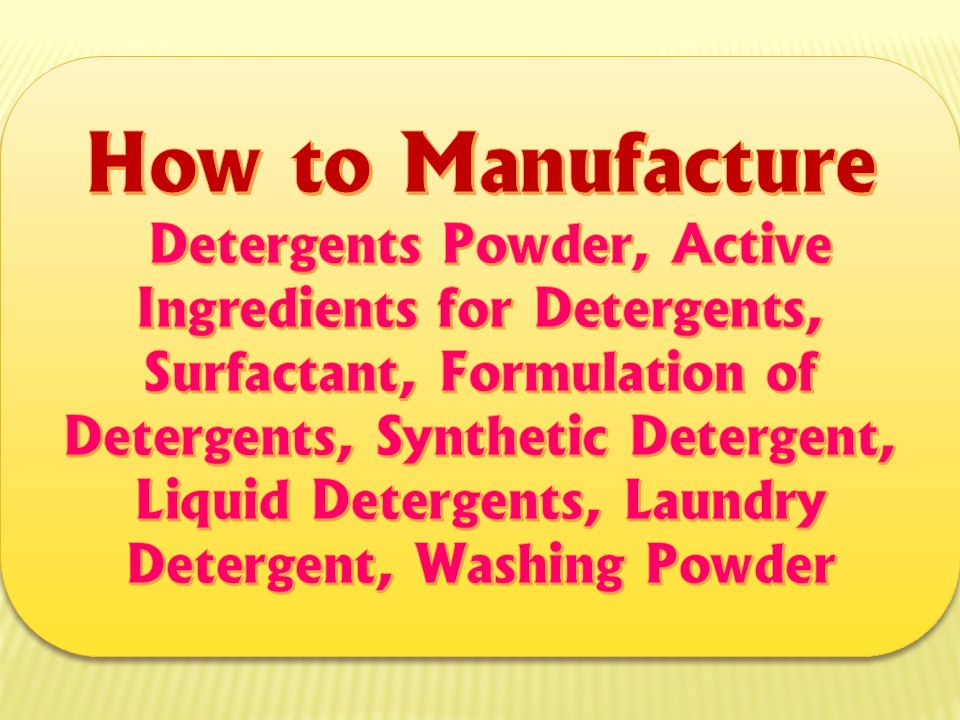
The detergent manufacturing process plays a vital role in producing both powder and liquid cleaning agents for households and industries. The industry has grown rapidly due to rising hygiene awareness, urbanization, and demand for convenience. Powder and liquid detergents dominate the market with different compositions and production methods. For manufacturers, knowing how to convert raw materials into high-quality detergents ensures better efficiency, sustainability, and profitability.
See Also : Metal & Chemical Extraction
Understanding the Detergent Manufacturing Process: From Raw Materials to Market-Ready Products
Key Ingredients in Detergent Production
The detergent manufacturing process starts with choosing suitable raw materials. These typically include:
-
Surfactants: These are the primary cleaning agents.
-
Builders: They enhance the efficiency of surfactants.
-
Enzymes and Bleaching Agents: Improve stain removal.
-
Fillers, Stabilizers, Fragrances, and Colorants: Added for performance and appeal.
Water, solvents, and thickening agents are also added, especially in liquid detergent formulations.
Powder Detergent Production Explained
To produce powder detergents, manufacturers use spray drying or dry mixing methods.
-
In spray drying, raw materials are mixed into a slurry and sprayed into a hot air chamber.
-
Moisture evaporates, leaving dry granules that are uniform and easy to dissolve.
-
Once cooled, additives like enzymes or fragrance are post-dosed to retain activity.
This method ensures free-flowing powder that doesn’t clump and has a long shelf life.
Liquid Detergent Manufacturing Process
Liquid detergents require a different system:
-
Surfactants are mixed with water, hydrotropes, and stabilizers.
-
Thickeners are used to give the liquid its viscosity.
-
The mixture is heated to ensure homogeneity, especially when solid raw materials are included.
-
pH adjusters and preservatives are added to maintain product stability.
After blending, filtration ensures a smooth texture free from lumps or undissolved solids. The product is then filled into bottles or pouches.
Switching from Powder to Liquid: What Changes?
Transitioning from powder to liquid detergent production brings changes in both equipment and formulation.
-
Powder production needs dry mixers, grinders, and dryers.
-
Liquid production requires agitators, heating systems, storage tanks, and liquid filling machines.
-
Liquid detergents often offer better solubility and gentleness on fabrics.
Despite differences, both formats rely on a structured detergent manufacturing process that emphasizes consistency, safety, and cleaning efficiency.
Packaging and Labeling: Preserving Quality
Packaging depends on the detergent type:
-
Powder detergents are pack in moisture-resistant bags or cardboard boxes.
-
Liquid detergents are fill into plastic bottles, pouches, or jars with precise labeling.
Automated machinery handles filling, sealing, labeling, and batch coding. Increasingly, companies are adopting eco-friendly packaging materials to reduce environmental harm.
Ensuring Quality Control at Every Step
Quality assurance is essential in the detergent manufacturing process:
-
Tests measure pH, viscosity, stability, and cleaning performance.
-
Microbial testing ensures product safety, especially for water-based liquid detergents.
-
Random samples are evaluate throughout production for batch consistency.
Reliable performance builds trust and boosts brand loyalty among consumers.
Innovations in Detergent Formulations
Modern detergent makers are introducing enzyme-rich, biodegradable, and non-toxic formulas. Key innovations include:
-
Cold-water detergents using enzymes that function effectively without heat.
-
Natural fragrances and plant-based surfactants.
-
Products designed to reduce water usage and environmental impact.
The trend toward green chemistry is reshaping how detergents are made and market.
Setting Up a Detergent Manufacturing Business
Entrepreneurs looking to start a detergent production unit must:
-
Obtain business licenses, factory permissions, and pollution clearances.
-
Choose between producing powder, liquid, or both.
-
Invest in quality raw materials and reliable machinery.
-
Hire skilled workers and train them in formulation and safety protocols.
Market research is essential to identify demand patterns and pricing strategy.
Automation in Detergent Manufacturing
Automation is improving speed and accuracy in detergent production. Key benefits include:
-
Real-time monitoring of chemical mixing, flow rate, and temperature.
-
Robotics for packaging, labeling, and palletizing.
-
Reduced labor costs and minimal human errors.
Automated control systems also help maintain consistent product quality across batches.
Exporting Detergents: Global Market Considerations
Manufacturers eyeing international markets must:
-
Adhere to global safety and labeling regulations.
-
Use multilingual packaging for better communication.
-
Get certifications like ISO, GMP, and eco-labels to build credibility.
Exporting requires robust logistics and marketing partnerships to distribute effectively.
Challenges in the Detergent Industry
Even with growth, several hurdles remain in the detergent manufacturing process:
-
Rising costs of surfactants and packaging materials.
-
Tough competition from established brands.
-
Frequent changes in government and environmental regulations.
Businesses must be flexible, innovative, and proactive to stay competitive in the detergent sector.
Sustainability and Eco-Friendly Practices
To future-proof operations, companies are:
-
Shifting to biodegradable raw materials and natural surfactants.
-
Reducing plastic by offering refill pouches and bulk packs.
-
Recycling wastewater and using renewable energy sources.
Sustainability is not only a trend but also a necessity in modern detergent production.
See Also : Rubber Processing & Manufacturing
Conclusion
The detergent manufacturing process is multi-layer and evolving. From selecting raw materials to packaging final products, each step requires careful control and technical know-how. Whether it’s powder or liquid format, manufacturers must focus on performance, consistency, and sustainability. As consumers become more environmentally conscious, the shift toward biodegradable and skin-friendly detergents continues. Understanding and optimizing the detergent manufacturing process can help businesses deliver competitive, high-quality, and eco-responsible products that dominate the market.





